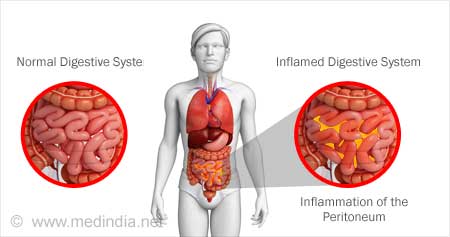Introduction
Bacterial peritonitis is a serious condition characterized by the inflammation of the peritoneum, the thin tissue lining the inner wall of the abdomen. It occurs when bacteria invade the peritoneum, leading to infection and subsequent inflammation. In this article, we will explore the definition, presenting complaints, diagnosis, treatment, and management of bacterial peritonitis.

Definition
Bacterial peritonitis refers to the infection and inflammation of the peritoneum caused by the presence of bacteria. It can occur as a primary infection, known as spontaneous bacterial peritonitis (SBP), or as a secondary infection due to other underlying conditions such as liver cirrhosis, appendicitis, or a ruptured appendix.
Presenting Complaints

Patients with bacterial peritonitis may present with a variety of symptoms, including severe abdominal pain, tenderness, distension, fever, chills, nausea, vomiting, and altered bowel movements. These symptoms can be non-specific and may overlap with other abdominal conditions, making it crucial to conduct a thorough medical evaluation.
History of Present Illnesses
When taking the history of present illness, it is important to inquire about the onset and duration of symptoms, any recent abdominal surgeries or procedures, and any known risk factors for bacterial peritonitis, such as liver disease or immunosuppression.
History of Past Illnesses
A detailed history of past illnesses can provide valuable insights into the patient’s overall health and any pre-existing conditions that may contribute to the development of bacterial peritonitis. Conditions such as liver cirrhosis, kidney disease, or a history of gastrointestinal surgeries should be noted.
Socioeconomic History
The socioeconomic history of the patient can provide information on their living conditions, access to healthcare, and potential exposure to risk factors for bacterial peritonitis. Factors such as homelessness, substance abuse, or poor sanitation can increase the likelihood of developing the condition.
Drug and Allergy History
It is essential to document the patient’s current medications, including any antibiotics or immunosuppressive drugs, as well as any known drug allergies. This information will guide the choice of appropriate antibiotics and prevent adverse reactions during treatment.
General Physical Examination of Patient
It is essential to document the patient’s current medications, including any antibiotics or immunosuppressive drugs, as well as any known drug allergies. This information will guide the choice of appropriate antibiotics and prevent adverse reactions during treatment.
Special Examination
In some cases, a special examination called paracentesis may be performed to obtain a sample of the peritoneal fluid for analysis. This can help identify the presence of bacteria and guide the choice of appropriate antibiotics.
Laboratory Investigation
Laboratory tests play a crucial role in diagnosing bacterial peritonitis. A complete blood count (CBC) may reveal an elevated white blood cell count, indicating an ongoing infection. Additionally, a culture of the peritoneal fluid can identify the specific bacteria causing the infection.
Radiological Examinations and Findings
Radiological imaging, such as ultrasound or CT scan, may be performed to assess the severity of the infection and identify any underlying causes, such as liver disease or appendicitis. These imaging studies can provide valuable information for the diagnosis and management of bacterial peritonitis.
Provisional Diagnosis and Differential Diagnosis
Based on the patient’s history, physical examination, and laboratory findings, a provisional diagnosis of bacterial peritonitis can be made. However, it is essential to consider other possible causes of abdominal pain and inflammation, such as appendicitis, diverticulitis, or gastrointestinal perforation, to ensure an accurate diagnosis.
Final Diagnosis
The final diagnosis of bacterial peritonitis is confirmed by the presence of bacteria in the peritoneal fluid culture and the characteristic clinical presentation. Additional tests may be performed to identify any underlying conditions contributing to the infection.
Complications
Bacterial peritonitis can lead to several complications if left untreated or poorly managed. These include septic shock, abscess formation, multi-organ failure, and even death. Prompt diagnosis and appropriate treatment are crucial to prevent these complications.
First Aid Treatment of Patients with Peritonitis
If bacterial peritonitis is suspected, it is essential to seek immediate medical attention. While awaiting medical help, the patient should be kept in a comfortable position, and oral intake should be avoided to prevent further complications. Do not attempt to administer any medications without proper medical guidance.
Treatment and Management at Home and Hospital

Treatment for bacterial peritonitis typically involves hospitalization and intravenous administration of antibiotics to target the specific bacteria causing the infection. In severe cases, surgical intervention may be necessary to drain any abscesses or repair perforations. Home management is not recommended, as close monitoring and specialized care are essential for a successful recovery.

Duration of Treatment
The duration of treatment for bacterial peritonitis can vary depending on the severity of the infection, the underlying cause, and the response to antibiotics. Typically, treatment may last for several weeks, and regular follow-up visits are necessary to ensure complete resolution of the infection.
Prognosis
The prognosis for bacterial peritonitis depends on several factors, including the patient’s overall health, the presence of underlying conditions, the promptness of diagnosis, and the effectiveness of treatment. With early diagnosis and appropriate management, the prognosis can be favorable.
Advice for Patients and Medical Students
For patients recovering from bacterial peritonitis, it is crucial to follow the prescribed treatment plan, take all medications as directed, and attend regular follow-up appointments. Medical students should familiarize themselves with the clinical presentation, diagnosis, and management of bacterial peritonitis to provide optimal care to future patients.
Conclusion
Bacterial peritonitis is a serious condition that requires prompt medical attention and appropriate treatment. By understanding its causes, symptoms, diagnosis, and treatment options, healthcare providers can provide effective care and improve patient outcomes.
Note: The information provided in this article is for educational purposes only and should not replace medical advice. Please consult a healthcare professional or write to me for personalized diagnosis and treatment. You are always welcome to offer comments. Please e mail for any assistance/ .





Comments
Post a Comment
If you have any query, doubt or seek any advice or help, I am always available.